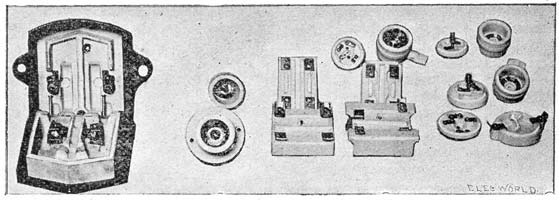[Trade Journal]
Publication: Electrical World
New York, NY, United States
vol. 28, no. 5, p. 150, col. 1-2
Some New Porcelain Specialties.
Pass & Seymour, Syracuse, N. Y., have just placed upon the market a number of porcelain specialties of ingenious design and construction, which are illustrated herewith.
At the left of Fig. 1 is shown one of their single-pole transformer cutouts. It is a little hooded house of cast iron, in which are two blocks of porcelain. The two wires enter the box from below and connect with the two terminals on the inner piece shown in the illustration at the top of the box. The other piece of porcelain, which is attached to the hinged cover, carries two contacts which are given a spring pressure against the line contacts in the box itself when the cover is closed. The cover contacts are united by a fuse. The fuse is enclosed in an incombustible chamber, lined with porcelain. Should the fuse blow, the mere act of opening the box disconnects it, when it may be replaced with a new fuse with perfect safety. The fuse chamber is suitably ventilated. The fuse is a long one, and when arranged in pairs the box is adaptable to high-tension primary circuits.
At the immediate right of the box are shown two receptacles, the upper one being of the weatherproof type and the other being designed for sign work. The adaptability of porcelain to these uses is unquestioned and the practical accomplishment of this adaptation by this firm is satisfactory in every way.
Next in order is shown at the right a branch block and a main-line telephone block. Grooves are moulded in both cover and block. Those in the cover are arranged to prevent the use of a fuse larger than that for which the block was designed, while the grooves in the block itself separate the fuses, each being in a porcelain-lined, ventilated compartment (see Fig. 3). The fuses are housed in the cover and by loosening four screws the cover may be removed together with the fuses. This is an obvious advantage and convenience in renewing fuses. The contacts of these boxes will take any wire from the smallest size up to the largest necessary to feed such a box at any commercial line loss. The contact screws are long and do not slip. The cover of the branch block fits the main-line block and vice versa.
 |
| Fig. 1. |
At the right of this latter illustration is shown a lice of porcelain sockets, which may be fitted interchangeably on bases, thus enabling them to be used as receptacles, chandelier sockets or drop sockets. The brass work may be interchanged so as to adapt them to the T.-H., or Westinghouse systems. A single screw holds the parts together, and makes the socket convenient to wire. The socket is fused, which is an obvious improvement over brass shell sockets. No one who has ever seen the effect of short-circuit on sockets of the latter class can question the superiority of porcelain for such uses.
 |
| Fig. 3 Fig. 2. |
On the extreme right of the illustration is shown a porcelain rosette constructed on the same principles as those employed in branch block work.
Figs. 2 and 3 show the "P. & S." covered main-line cut-out complete (Fig. 2), Fig. 3 showing the interior construction of the cover which holds the fuses.
In Fig. 3 it will be noticed that the fuses are contained in separate channels, AA. When the cover is on the box these channels, as well as the fuse contacts, are separated by the projection on the base which fits into the recess, C, in the cover. The brass plates on the cover interlock with the line contacts on the base, and are held by the screws shown on top of the cover. These cut-outs are made in 15, 30 and 60 ampere sizes.
The interchangeability of the parts of these devices at once attracts attention, and this feature is a boon to the contractor and the general dealer in supplies. Breaking a cover or a part does not necessitate the rejection of the whole; parts therefore that are intact can be usefully employed. With a very small stock of extra parts a dealer is enabled to make a complete Westinghouse drop-socket, where he originally had only T.-H. receptacles in stock. The same advantages, of course, apply to the main and branch blocks.
